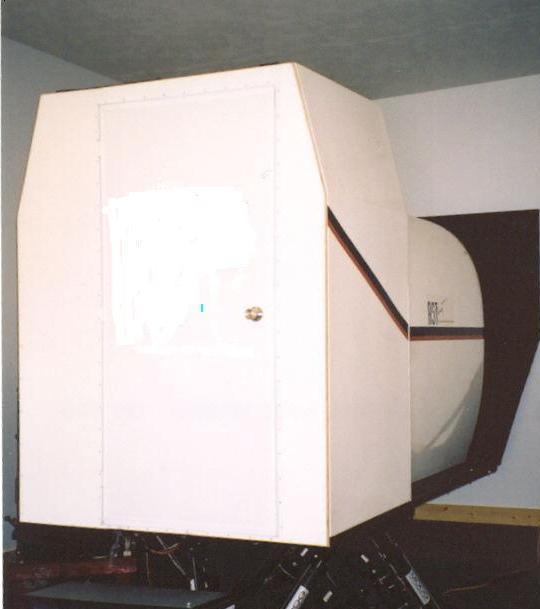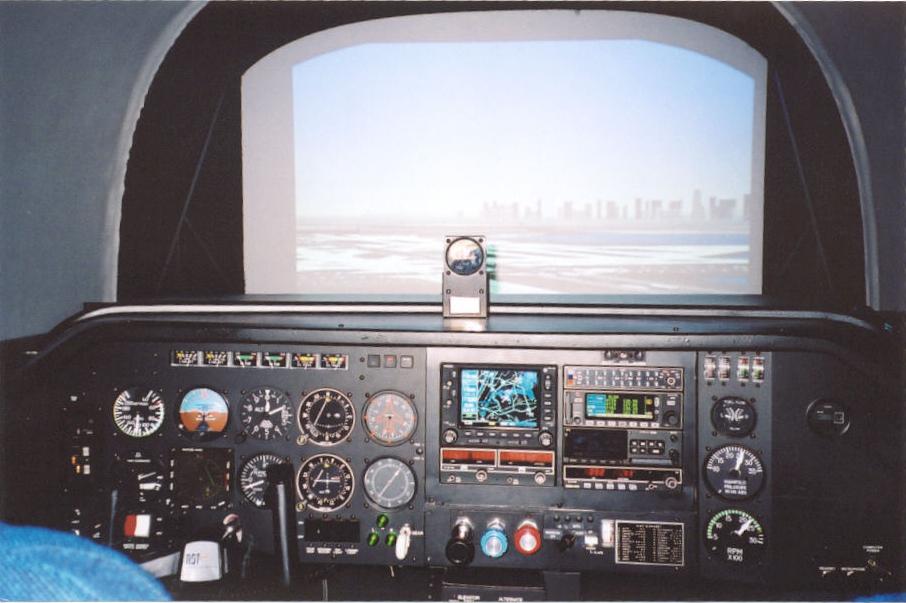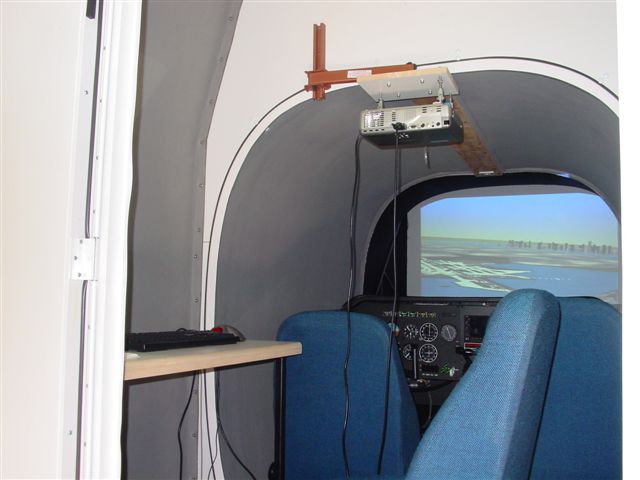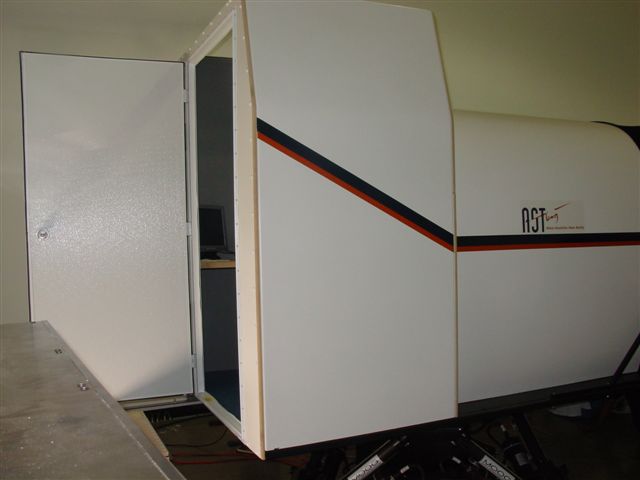Full Motion Simulator
Cessna 210 SimulatorCessna T210 SimulatorCessna P210 Simulator
Advanced Instrument Training

The
flight began as a routine cross-country instrument flight, though
increasing headwinds delayed arrival until after dark; the pilot began
a gradual decent from FL190 to lessen the headwinds. Then the pilot
found himself in IMC as unforecast rain developed, though the
destination remained above approach minimums. As the rain and clouds
came in, turbulence picked up. Slowly the panel lights began to dim,
and soon it became apparent that a flashlight would be needed to fly
the plane after a night-time electrical failure. All electrical
devices were turned off except the VNAV-capable GPS navigator. The pilot began navigating to an alternate with
known VFR weather when the engine began to sputter and die… alone,
at night, at high altitude in a dark cockpit with no engine and only
reserve battery power to power the available navigation equipment. The pilot navigated to the final
approach fix for a nearby instrument runway and enroute he calculated
his airplane’s descent rate in order to determine the proper
adjusted altitude at which to cross the FAF…knowing there would be
only one chance at this approach, he monitored his airplane’s
descent rate intensely, circled over the FAF a few times, and then
glided inbound from the missed approach point… Breaking out of the
clouds to the wonderful sight of sequenced approach lights, he
extended the gear manually and made a no-flap deadstick landing to the
great relief of everyone involved.
“Awesome” is the response heard most often after a pilot learns of
the capabilities of Flight Level Aviation’s full-motion advanced
avionics simulator, in which the above flight can be realistically
enacted. Custom manufactured by Aviation Simulation Technology (www.ast-simulators.com),
this unique simulator gives the single-engine instrument pilot the
ability to practice single-engine emergencies just as realistically as
twin pilots typically practice engine failures during recurrent
simulator training. The simulator also is equipped with a
twin-engine throttle quadrant to practice realistic engine failures in
all phases of multi-engine flight, including engine failures on
takeoff leading to Vmc rollovers if not quickly managed. In addition, this simulator allows pilots to gain
actual experience flying 3 different IFR GPS systems and the Sandel SN3308
Electronic HSI, learning the various nuances, modes, and advanced
features of these avionics in the more efficient setting of the
simulator before trying them out in an actual airplane.
The simulator's full-motion model allows realistic practice of unusual
attitudes in IFR or VFR weather conditions, mild or extreme crosswind landings, steep turns, cockpit
resource management during single-pilot instrument approaches in
turbulence, and many other training scenarios helpful for single-pilot
single-engine IFR flight. Emergency situations which can
be simulated include asymmetric flap deflection, instrument and gyro
malfunctions, electric trim runaway, electrical failures, and even
wake turbulence rolls while in either VFR or IFR weather conditions. The simulator has an extensive
navigation database which allows pilots to fly approaches both in
their own home area as well as throughout the U.S.
The simulator specifications are as follows (all avionics are
authentic and fully functioning):
- Certified
as an FAA Level 3 Flight Training Device -- Certification
Completed 9/22/03 -- This is the ONLY Full-Motion Level 3 Flight
Training Device for light piston singe-engine or multi-engine aircraft!
- Full 6-Degree Freedom of Motion
System from Moog Inc. (www.moog.com)
- Approved for Instrument
Proficiency Checks with a CFII
- Approved for Instrument
Currency with a CFII or Instrument Ground Instructor
- Bendix-King
KX-165 VOR/ILS
Receiver
- Sandel SN3308 Electronic HSI
interfaced to 3 IFR GPS navigators, VOR/ILS, and ADF
- Garmin 530 IFR GPS
- King KLN94 IFR GPS with IFR-style
annunciator panel
- UPSAT GX50 IFR GPS with IFR-style
annunciator panel
- King KR87 ADF Receiver
- Generic Single-engine
or Multi-engine piston Cockpit
- Authentic simulator flight models from Kohlman Systems Research, Inc. (www.kohlmansystems.com)
for Cessna T210/P210, normally aspirated Piper Saratoga, Piper
Seminole, or generic turbocharged twin
- 60-Degree Visual Projection System
- Extensive, custom-programmed
systems failure scenarios for single-engine or multi-engine single-pilot IFR
training
As an FAA certified Level III
Flight Training Device, use of
this simulator will qualify for the following Part 61 operations:
61.109 Private 2.5 hours out of 40
hours flight time
61.65 Instrument 20 hours out of 40 hours instrument time
61.129 Commercial Not more than 50 hours out of 250 hours total
flight time
61.156 ATP Not more than 25 hours out of 75 hours flight instrument
time
61.65 Portions of Instrument Check Ride
61.57 All 6 approaches required for an Instrument Currency (with
a CFII or Instrument Ground Instructor)
61.57 All or part of an Instrument Proficiency Check (with a
CFII)
This simulator is an extremely
cost-effective way to maintain instrument currency, to practice using
an IFR GPS, or to complete up to 20 hours of training toward an
instrument rating.
Training scenarios and failure modes
which can be practiced in the simulator include these:
- AI/DG Failure on Takeoff
- Engine failure on takeoff in
single-engine or multi-engine airplane
- VMC Unusual Attitudes
- VMC
Rolls/Loops/Inverted/Knife-Edge Flight
- IMC
Rolls/Loops/Inverted/Knife-Edge Flight
- Asymmetric Flap Extension
- Sandel SN3308 Electronic HSI
Operation
- Conventional HSI Operation
- King KLN94 Operation
- Garmin 530 Operation
- UPSAT GX50 Operation
- Low Visibility Takeoff
- Mild or Extreme Crosswind
Landings, with or without Windshear
- Wake Turbulence Rolls
- Airway Tracking with an IFR GPS
- Blocked Pitot Port
- Partially Blocked Static Port
- ILS Approach to Minimums with
Windshear
- Single-Engine Vmc Cut
- False Glideslope Intercept
- Glideslope Failure
- ASR (Airport Surveillance Radar)
Approach
- PAR (Precision Approach Radar)
Approach
- GPS Approach
- NDB Approach
- VOR Approach
- LOC Approach
- LOC Backcourse Approach
- VOR/LOC DME Stepdown Approach
- RNAV (GPS) Approach
- SDF Approach
- LDA Approach
- LDA/Glideslope Approach
- DME Arc Approach using DG or HSI
or RMI or GPS
- Contact Approach
- Circling Approach to Minimums at
Night (within range of simulator's 60 degree visual system)
- Missed Approach in low IMC
- Holding at random GPS waypoints
- No-flap landings
- Higher speed or expedited
approaches at busy airports
- Category III 0/0 emergency ILS
approach/landing
- Deadstick instrument approach to
full stop at night to approach minimums
- Holding procedures below vs. above
10,000 feet
- Using GPS as replacement for VOR
DME or LOC DME for enroute or approach purposes
- Descent rate calculations for
precision vs. non-precision approaches
- Re-Creation of Accidents which
have previously occurred in student's airplane type
- Controlled Flight into Terrain
Avoidance Scenarios on IMC Departures from Controlled vs.
Non-Controlled Airports
- Instrument approaches with varying
winds aloft during descent
- Holding, DME Arcs, and NDB
approaches with high winds aloft
- Class B vs. Class C vs. Class D
vs. TRSA entry procedures
- Emergency descent from FL200
- Base to Final Stall/Spin
- Advanced GPS Flight Plan Features
- Master Solenoid Failure
- Battery Failure
- Alternator Failure
- Altimeter Failure
- IMC Unusual Attitudes
- Spin Recovery in IMC
- Stall Recovery in IMC
- Partial Panel in Multiple
Configurations
- Stuck Throttle at Varying
Power Settings
- Engine-Driven or Electric Fuel Pump
Failure
- Runaway Electric Trim
- Minimum Visibility Approach in Fog
- IFR Problem Solving with Various
Weather/Mechanical/ATC Scenarios
- Airspeed Indicator Failure
- VSI Indicator Failure
- "Slam Dunk" Descent Profile
Approach
- Cold Temperature Effects on
Altimeter
- "No Panel" GPS Approach
- Use of High-Altitude Enroute
Charts
- Oil Lead Leading to Imminent
Engine Failure
- Engine Failure on Takeoff at
Varying Critical Altitudes
- Use of OBS/Leg Modes on IFR GPS
- Holding Procedures with Varying
Avionics Equipment
- Gliding Distance to Shore Over
Water with Varying Winds Aloft
- Portable Weather Datalink
Operation (Palm VIIx)
- Navaid ID procedures (by audio or
digitally) including DME
- Fuel Controller Failure
- IFR Crossing Altitudes During Lost
Communication Procedures
- ATC Negotiations in Icing
Conditions
- Sandel Bearing Pointer Setup
- "Cancel IFR" Scenario in Class E
Airspace
- Garmin 430/530 GPS
Setup/Customization
- Turn Toward Converging Traffic
Midair-Avoidance Scenario
- Behind Power Curve Approaches

Close-Up View of Simulator Panel

Simulator External View

Full
Simulator Panel with Avionics Visible, including Garmin 530, King
KLN94, UPSAT GX50, and Sandel SN3308 Electronic HSI

Simulator Interior with Pilot Seat, Instructor Console, and Projected
Visual System in View

Simulator Exterior View